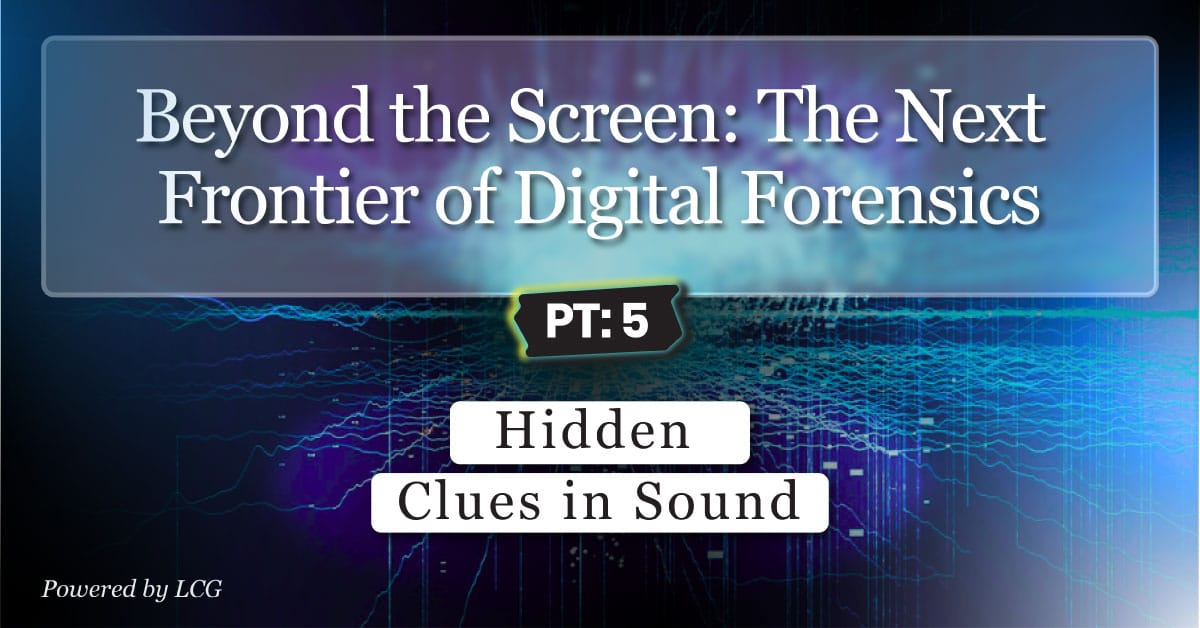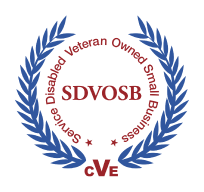Hidden Clues in Sound: Using Background Noise as Forensic Evidence
Contributed by Kris Carlson, COO, Former ICAC Commander, and Digital Forensics Investigator/Testifying Expert
How ambient audio strengthens or sinks authenticity, timeline, and location claims
Series context. Building on our work with deepfake voices, mobile artifacts, and video metadata, this installment focuses on ambient audio, how to extract it safely, and how to present it so judges and juries can trust it. [1]
Why “noise” is evidence
Smartphones, bodycams, and doorbells capture more than video; they also capture what is not seen, which can include audio clues and information. Audio can include air conditioners cycling, trains passing, church bells, TV newscasts, room reverberation, background voices, and the subtle mains hum of the power grid. Those “background” elements can corroborate or contradict where and when a clip was recorded, what happened during an incident, and whether it was edited. Courts still expect foundational authenticity under Federal Rule of Evidence 901, and they scrutinize expert methods under the amended Rule 702, which emphasizes the proponent’s burden and curbs expert overstatement. [2][3]
In practice, defensibility hangs on process. Follow discipline-specific guidance for forensic audio, not convenience utilities, or you risk exclusion. [1] The payoff is real: analysts can use background noise to estimate timelines, flag edits, and test claims about location and events. These methods are powerful, but they could have documented limits that must be disclosed. [4][7]
LCG perspective. Treat ambient audio like any other forensic artifact: preserve first, analyze on validated copies, and report methods and uncertainty transparently. In short, avoid making statements or offering opinions that outrun your data and the forensic record. [3]
A practical playbook for ambient audio
- Preserve originals immediately. Protect source media, capture device metadata, compute cryptographic hashes, and document the chain of custody.[5]
- Work from verified duplicates. Maintain a clean lab log. Note software, versions, plug-ins, and settings. [6]
- Do a structured “ambient triage.”
- Time anchors: newscasts, countdowns, alarms, church bells, or transit schedules heard in the background;
- Location cues: unique mechanical sounds, public transit, background sounds, identifiable wildlife, or public address systems;
- Integrity artifacts: discontinuities, codec re-encodes inconsistent with the alleged device or app. [1][4][9]
- Enhance conservatively, never destructively. Save every intermediate file. Log each filter, parameter, and order of operations so the work is reproducible. Distinguish enhancement for intelligibility from authentication for integrity. [9]
- Be clear on scope and uncertainty. Report what your methods can and, equally as important, cannot conclude. Quantify error where literature supports it and avoid probabilistic wording that suggests precision you do not have. [3][4]
- Anticipate courtroom challenges. Be prepared to address Frye/Daubert questions and be familiar with reliability debate, disclosure expectations, and how courts have treated such evidence. [8]
From method to mapping standards, pitfalls, and mitigations
Map your workflow to accepted guidance. ISO/IEC 27037 provides the evidence-handling spine from seizure to storage. [5] SWGDE’s Best Practices for Forensic Audio define technician competencies, documentation patterns, and reporting elements for audio work. [1] Use NIST or other validated reference datasets and quality frameworks to validate filters, detectors, and your lab environment before casework. [6]
Common pitfalls, with proven mitigations.
- Hidden recoding and format drift. Messaging apps and social platforms re-encode audio.
- Mitigation: confirm the alleged device and app behavior, collect platform originals, and cite the encoding chain in your report. [1]
- Over-enhancement that creates artifacts. Excessive denoising can hallucinate content.
- Mitigation: bracketing approach, keep unprocessed and minimally processed references, and disclose enhancements clearly. [9]
- Foundational gaps under Rules 901 and 702. Missing provenance, unclear methods, or unvalidated tools invite exclusion.
- Mitigation: ensure a clean chain, transparent methodology, and literature-backed techniques; structure your testimony around what the rules actually require. [2][3]
LCG perspective. Background audio can help with cases when it is one part of a layered proof. Prioritize converging lines of evidence, align your technical work to published guidance, and write reports that a non-engineer can follow. [1][4][9]
Quick Checklist
- Preserve the source and hash it; log every step. [5]
- Analyze ambient cues systematically. [7][9]
- Report methods, parameters, limits, and uncertainties plainly to meet 901 and 702. [2][3]
Final thought
Ambient audio is not clutter; it can provide valuable evidence or important context. When you preserve it correctly, analyze it with validated techniques, and explain the limits with candor, it can corroborate timeline and location claims or reveal edits that change outcomes. The reward is a record the court can trust, and the risk of exclusion is minimized by disciplined handling and honest reporting. [1][2][3]
References (endnotes)
[1] Scientific Working Group on Digital Evidence (SWGDE), “Best Practices for Forensic Audio,” v2.5, 2022, pdf. https://www.swgde.org/documents/published-complete-listing/08-a-001-swgde-best-practices-for-forensic-audio/ (SWGDE – SWGDE)
[2] Federal Rules of Evidence, Rule 901, “Authenticating or Identifying Evidence,” Legal Information Institute. https://www.law.cornell.edu/rules/fre/rule_901 (Legal Information Institute)
[3] Federal Rules of Evidence, full rules including 2023–2024 amendments; see Rule 702 and Committee Notes, U.S. Courts. https://www.uscourts.gov/sites/default/files/2025-02/federal-rules-of-evidence-dec-1-2024_0.pdf; see also Mark A. Behrens & Andrew J. Trask, “Federal Rule of Evidence 702: A History and Guide to the 2023 Amendments,” 2024. https://www.shb.com/~/media/files/professionals/b/behrensmark/federal-rule-of-evidence-702–a-history-and-guide.pdf (United States Courts)
[4] Robert C. Maher, “Lending an Ear in the Courtroom: Forensic Acoustics,” Acoustics Today, 2019, pdf. https://acousticstoday.org/wp-content/uploads/2019/10/Lending-an-Ear-in-the-Courtroom-Forensic-Acoustics-Robert-C.-Maher.pdf (Acoustics Today)
[5] ISO/IEC 27037:2012, “Guidelines for identification, collection, acquisition and preservation of digital evidence,” ISO. https://www.iso.org/standard/44381.html (ISO)
[6] NIST, “Computer Forensic Reference Data Sets (CFReDS),” updated Mar. 26, 2025. https://www.nist.gov/programs-projects/computer-forensic-reference-data-sets (NIST)
[7] Hui Su, Ravi Garg, Adi Hajj-Ahmad, Min Wu, “ENF Analysis on Recaptured Audio Recordings,” IEEE ICASSP, 2013, pdf; and Nature Sci. Reports, “1D-CNN-based audio tampering detection using ENF signals,” 2024, pdf. https://user.eng.umd.edu/~minwu/public_paper/Conf13/1305_ENFaudio_icassp13.pdf; https://www.nature.com/articles/s41598-024-60813-0.pdf (User Eng UMD)
[8] National Association of Criminal Defense Lawyers (NACDL), “Litigating ShotSpotter Evidence: The Science and the Law,” Dec. 3, 2021. https://www.nacdl.org/Content/Litigating-ShotSpotter-Evidence-The-Science-and-th (NACDL)
[9] SWGDE, “Best Practices for the Enhancement of Digital Audio,” 2023 draft v2.0, pdf. https://www.swgde.org/wp-content/uploads/2024/02/2023-07-25-SWGDE-Best-Practices-for-the-Enhancement-of-Digital-Audio-20-A-001-2.0.pdf (SWGDE – SWGDE)
This article is for general information and does not constitute legal advice.







